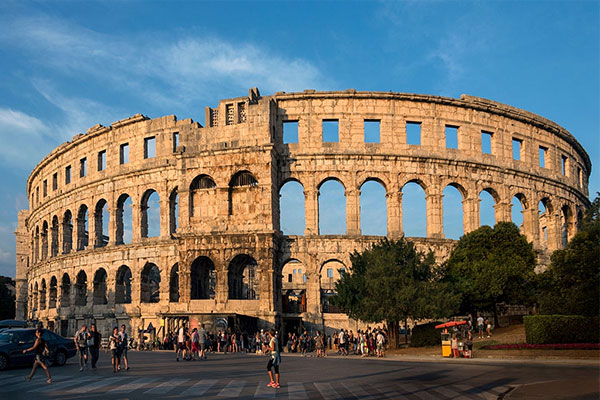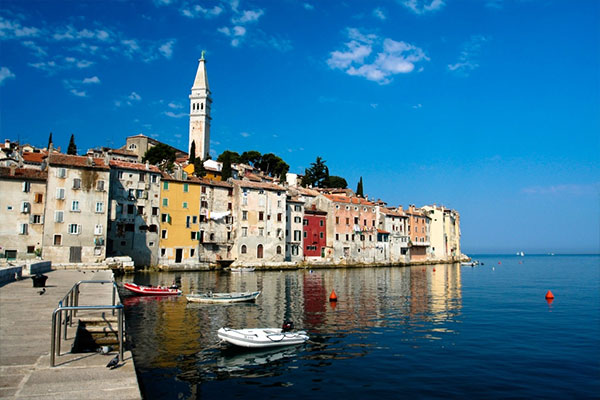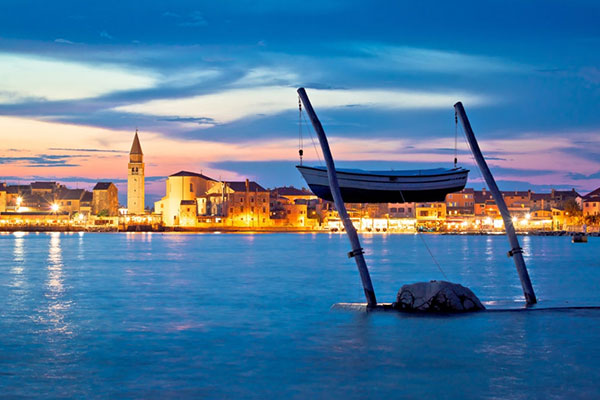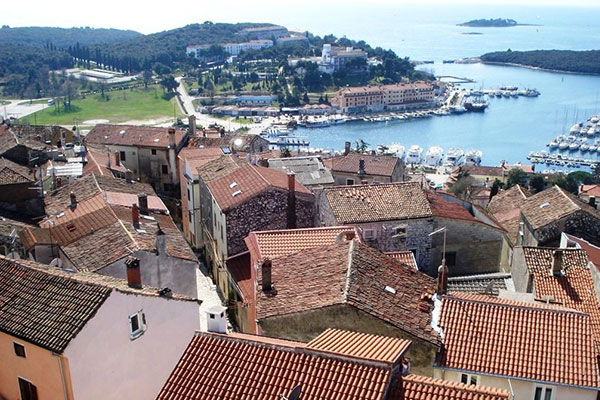Istria
Istria is a narrow peninsula of Croatia situated in the northern part of the Adriatic Sea, affording a geographical area typical for cordiality and hospitality of their people. The inhabitants of this region, socially and religiously mixed, are proud of common Istrian tradition regarding their cultural values.
Cities in the region Istria:
About
Istria is a narrow peninsula of Croatia situated in the northern part of the Adriatic Sea, affording a geographical area typical for cordiality and hospitality of their people. The inhabitants of this region, socially and religiously mixed, are proud of common Isrian tradition regarding their cultural values.
This is a place where you can both admire cultural heritage and the beautiful coast crowded with bays, where the deep blue color and green landscape appear to be endless. Small towns still have interesting historical buildings made in stone.
There are high towers in small places, which are circled by meadows of Spanish broom and olive trees. The typical agricultural products of this area, combined with the fruits of the sea guarantee gastronomical and enological satisfaction for every taste.
Useful info
Registering your stay
Owners of accommodation in areas with tourist activities are required to register the stay of tourists with the local tourist community of the respective village or city. The tourist community is then required to issue a written residence permit for each registered quest. Tourists pay a fee for each day of their stay. Children up to 12 years of age are not required to pay a fee to stay, and children between 12 and 18 years of age pay 50 % of the fee.
Tourist health care
During their stay in Istria, tourists are entitled to medical services at health stations and hospitals at minimum cost that is charged to Croatian citizens. Visitors from the Czech Republic, Slovakia, Poland, Hungary and Great Britain are obliged to present only their passport. Aside from the passport or identity card, visitors from Germany must present the HR-D 111 form, from Austria the A/HR 3 form, from Italy the MO-7 form.
Visitors from the Netherlands, beside their passport, are obliged to present the YN 111 form, those from Belgium the BY 11 form, from Slovenia SLO-HR 3 form. In larger towns one pharmacy is open 24 hours a day, 7 days a week. Tourists may choose private medical doctors and dentists where a full price is charged for medical treatment.
Traffic
Road traffic
The same regulations as elsewhere in Europe are valid on the roads of Istria. Speed limitations are marked on individual roads.
Permitted speed:
- in towns 50 km/h
- out of towns 80 km/h
- on major motor routes 100 km/h
Tolls for tunnel Ucka:
Category Tolls(Kuna)
I 26.00
II 37.00
III 75.00
IV 150.00
Gas stations work according to the established schedule, and some of them, mainly on major roads are open 24 hours a day. In case of car defect or accident call HAK (Croatian Automobile Club) AK Pula-Rovinj, tel. 214 972 or 540 987. Services are paid in cash, by cheque or credit cars. HAK and ADAC members may pay services rendered to them by coupons or a letter of credit. HAK is member of AIT and FIA.
Airports in Istria
Airport of Pula
tel 550-900, e-mail: zracna-luka-pu@pu.tel.hr
Tourist airport of Vrsar
Tel 441-350
Sport airport Delic Air- Medulin
Tel 441-350; 098-420-577
Master port
ACI Pomer- tel +385-52-573-162
ACI Pula- tel +385-52-219-142
Aci Rovinj- tel +385-52-813-133
ACI Umag- tel +385-52-741-066
Marina Novigrad- tel +385-52-757-077
Marina Porat-Cervar- tel +385-52-436-661
Marina Parentium- tel +385-52-452-210
Marina Porec- tel +385-52-451-913
Marina Vrsar- tel +385-52-441-053
Marina Valalta- tel +385-52-811-033
Marina Veruda- tel +385-52-211-033
Nautical tourism
The owner or driver of boat over three meters in length and with a motor over 4 kw must, immediately after entering Croatian territorial waters, register their arrival and stay with the next appropriate port authority, in so far as they intend on traveling along the coastline and to the islands. Water vehicles arriving by way of land can be registered with any port authority. The boat driver is required to register all people on board.
Gastro
The Istrian gastronomy faithfully reflects all the historical, geographical and climatic characteristics of this area. The tumultuous past times considerably impacted the gastronomy as well. Various traditions are interlaced in the traditional cuisine which found its fundaments in the nature (self-propagating plants, aromatic condiments, seasonal vegetables, sea fruits…).
The best known Istrian spoon meal – maneštra – is deeply rooted in the region’s culinary traditions. Once the most common meal on Istrian tables, and often the only one, maneštra is fashionable once again. The basis of Istrian maneštra are boiled potatoes and beans to which seasonal vegetables are added that give it a distinct name: maneštra od bobići (young corn), od jačmika (barley), od slanca or slanutka (chickpea), od koromača (fennel), and so on. When pickled cabbage (sauerkraut) or sour turnip is added, it becomes jota – a typical winter dish.
A unique characteristic of Istrian maneštras is pešt (pesto). Pešt is made by mashing together chopped bacon, garlic and parsley to form a paste. It is added to the soup at the very beginning so the bacon is well cooked.
On their way from the Italian regions to Istria, names and shapes of pasta gradually changed until they became uniquely Istrian. Lovers of Italian pasta would be surprised at what Istrians call lasagna: it is not large flat noodles with layers of sauce and cheese, but any dish that uses the flat noodle. Their simple form makes them ideal for many dishes, including a lithesome nest for white truffles. Besides the large lasagna, there are also thin lasagna for soups and the slightly larger ones for maneštra.
Ravioli, or filled pasta, plays an important role in the Labin area where krafi are filled with a cheese, walnuts and raisins, cooked and then browned with a sweet sauce.
Istrian ham is highly regarded by gourmands worldwide due in large part to our strict adherence to a long tradition of respectful production – from the careful way pigs are raised, to the elaborate treatment of the meat, to its curing with a unique blend of spices that give the ham its distinctive fragrance. Since Istrian ham is produced without nitrites, nitrates or smoke, which also contains noxious chemicals, it is considered one of the most healthful cured meats in all of the Mediterranean.
The white Istrian truffle is one of the most highly appraised truffle species in the world. For decades, it has been smuggled out of our country in order to enrich the taste of various European cuisines where its origins have constantly been kept in concealment.
Recreation
Diving
Apart from the versatile flora and fauna, the Istrian sea abounds in shipwrecks that are becoming more and more interesting to diverse, recreationists and professionals. Numerous diving clubs are willing to organize and lead underwater expeditions. They also rent diving equipment. Because of mild sea temperature diving is possible all year round. More about diving you have on: www.diving-hrs.hr
Tennis
Istria is famous for tennis. There are some 430 clay courts for playing tennis throughout the year. The Istrian town of Umag hosts the famous ATP TOUR CROATIA OPEN , and the list of well-known tennis stars that heve already participated includes Goran Ivanisevic, Thomas Muster, Carlos Moya, Andrej Medvedev, Emilio and Javier Sanchez…
Golf
Although Istria is yet to become a real golf destination by the construction of a dozen golf courses, one can already spend a nice time playing golf in one of its heavenly corners on the Brijuni Islands. The golf course on Veli Brijun has 9 holes and the natural landscape abounds in interesting obstacles.
Bike trails
From the north to the south, from the east to the west coast of Istria, on nearly 2 600 kilometers spread the already plotted sixty bike trails.
Windsurfing
Those fond of windsurfing will find that the favorable winds and sea currents offer a unique experience. For skilled surfers more favorable is the southern part of Istria where the currents are very strong and winds “demanding”. Nearly all tourist places along the coast rent windsurfing equipment.
Sailing courses:
in Pula and Rovinj
Windsurfing courses:
in all larger tourist villages and camps
Hiking trails
Istria offers hikers hundreds of kilometers of marked trails all year round, from Crna Punta Skitaca, Gracisce to Ucka and Cicarija as far as Slovenia. There are three climbers’ chalets on Ucka, Korita and Zbevnica. Before taking such a trail it is advisable to contact the local tourist office or hiking club that offer a professional guide and organize more attractive hiking beyond the usual routes. More info: Planik hiking club Umag or hiking club Buje
Paragliding and hang gliding
Due to excellent climatic conditions, paragliding can be practiced all year round in Istria. Its five locations: Kastelir near Novigrad, excellent for beginners, Raspadalica, Brgud on Ucka, Lanisce, Zbevnica and very peak of Ucka, are suitable also for hang gliding. All starting positions are located in such a way that, regardless of the wind, one can takes off from any of them within a diameter of 30 kilometers.
Free climbing
Istria offers so far nine climbing sites: Zlatni Rt near Rovinj, Lim Bay, Dvigrad, Istarske toplice, Raspadalica above Buzet, Vranjska draga near Ucka tunnel, Pazin, Moscenicka draga near Pula and Rabac.
Nine ascents on the so-called short rocks, 20 – 30 m high, have 270 equipped ascents. Istrian rocks, full of various obstacles, are demanding both for top athletes and beginners.
Visit
THE AMPHITHEATER OF PULA
The Amphitheater of Pula (1st century), the popular ARENA, is the largest ancient structure in Istria, ellipse measuring 132 m x 105 m and a height of 32 m.
BRIJUNI ISLANDS-national park
As the only national park on the Istrian Peninsula, Brijuni with their 14 islands covering an area of 736 hectares are the most interesting and indented group of islands in Istria. The abundance of flora originating from the very beginning of the 20th century, with its forms creates a unique green species, deer, mouflon and other large game.
EUPHRASIAN BASILICA
The Euphrasian Basilica in Porec dating from the 6th century entered on the UNESCO World Heritage List in 1997.
LIM BAY-protected landscape and special marine reserve
Lim Bay is a flooded karst valley. Its narrow, yet long (11km) inlet represents one of the most beautiful landscapes in Istra.
It is a geomorphologic phenomenon with overgrown canyon cliffs rising up to 150m above sea level.
ZLANTNI RT – forest park (Punta Corrente)
On the southern side of the town of Rovinj lies the first protected forest park in Istria, about 100 years old. It is one of the most significant park complexes in the coastal region, of great aesthetic and botanical importance.
Numerous meadows are divided by lines of various species of tall cypresses, stone pines, fir-trees, Douglas firs, cedar trees, among which the deodar cedars (Cedrus deodara) are specially worth mentioning.
CAPE KAMENJAK and the Medulin Islands
The unusually indented southernmost cape of the Istrian Peninsula is equally interesting viewed from land, air or se. It is one of the last oases of the coastal region that has preserved its original appearance-a mosaic of cultivated fields, pastures and green groves immersed in the deep blue sea.
Resembling at first glance scorched land of the southernmost tip of Istria, Cape Kamenjak conceals great secrets of nature. Owing to the endemic vegetation and very specific habitat of certain bird species, Cape Kamenjak has been proclaimed a protected landscape.
BAREDINE CAVE
Baredine Cave is presently the only touristically valued geomorphologic nature sight in Istria. This cave, 132m deep with 5 chambers and Siphon Lake is rich in stalactites and stalagmites of unusual forms. The underground animal world is just as interesting; apart from the proteus anguinus one finds here miniature transparent crayfish and insects.
Tel 421-333, fax 427-714, e-mail: jama-baredine@pu.tel.hr
PALUD-ornithological reserve
Swamp and ornithological reserve Palud near Rovinj is the perfect stop both for birds and people. This is the temporary or permanent habitat of more than 200 bird species. During migrations one can see truly rare bird species at this bird refuge. This is the ideal destination for all bird-watchers. There is professional guide at the reserve.
Dvigrad
Dvigrad is the largest town of ruins. It was abandoned in the 17th century following an epidemic of plague. Cultural monument covering 16 000 square meters.
Wines
Sun soaked hills, fertile Istrian soil and the horny hands of Istrian farmers have for centuries been the prerequisites for the production of fine and top-quality wine. Today the new generation of Istrian winemakers struggles with the experience of the older ones, striving and succeeding in modernizing the traditional winegrowing techniques. This is one of the reasons why Istrian wines are ranked among the leading wines in Croatia. Istrian wines have also received numerous international awards.
One of the typical Istrian wines is Malvazija, the symbol of Istria, which hasn’t changed for over one hundred years. Teran and its subtype Refosk are typical Istrian red wines. There are also varieties such as the red wine Borgonja and rose called Hrvatica. Among the fine wines one should surely taste white and gray Pinot, Chardonnay, Cabernet and Merlot as well as Muscat.
In just the last ten years Istria has become the leading region in the production of Croatian high-quality wines. Istrian wines have become recognizable and highly esteemed, not only as part of the Istrian tradition and its beneficial climate, which they have always been, but they have been greatly awarded at numerous international wine fairs. Six wine roads have been marked and organized in the regions of Porec, Buje, Buzet, Rovinj, Vodnjan and Pazin, with nearly 70 wines cellars. Istria has earned its status as a wine Mecca. Some will point out that by its shape Istria resembles a bunch of grapes. Perhaps this is the very secret of the centuries-old connection between Istria and its fine varieties of wine.
Soup with red wine
From the distant past Istrian soup has been a specialty at the Istrian table. Nine deciliters of warmed up red wine – Teran or Borgonja, are poured into the bukaleta, usually an earthenware jug. Then a teaspoon of sugar, olive oil, pepper and warm, toasted bread are added to the wine. A spoon is placed in the jug and it is served to the quests, which if they wish may drink it in the traditional friendly Istrian way – by sharing the bukaleta with others at the table.









